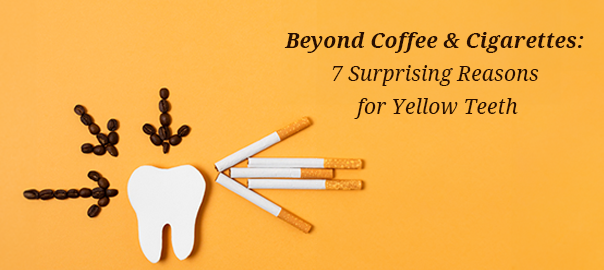
Beyond Coffee and Cigarettes: 7 Surprising Reasons for Yellow Teeth
A common concern among dental patients is: “Why are my teeth yellow when I brush them everyday?” While most individuals understand that coffee consumption and tobacco use contribute to dental discoloration, numerous lesser-known factors can affect tooth coloration. Dental practitioners frequently encounter patients expressing concern about yellowing teeth despite maintaining good oral hygiene practices. This comprehensive analysis explores several unexpected contributors to dental discoloration that extend beyond commonly known causes.
1. The Complex Nature of Tooth Discoloration
Tooth discoloration develops through various mechanisms affecting both the enamel and underlying dentin. Regular brushing alone may not address all these mechanisms, leading patients to wonder why their teeth remain yellow despite diligent oral hygiene. Understanding these processes helps practitioners and patients address the root causes effectively. The interaction between external factors and tooth structure creates a complex dynamic that influences overall tooth appearance.
2. Genetic Predisposition to Yellowing
Genetic factors significantly influence tooth color, though this aspect often goes unrecognized. Natural variations in enamel thickness and dentin color create inherent differences in tooth appearance. Some individuals inherit enamel characteristics that provide less protection against staining agents, while others naturally possess darker dentin shades that become more visible as enamel thins with age. This genetic component explains why some people maintain yellower teeth despite regular brushing.
3. Medication-Induced Discoloration
Various therapeutic medications can affect tooth coloration through different mechanisms:
- Antihistamines may reduce salivary flow, creating an environment conducive to staining
- Antipsychotic medications can alter mineral deposition patterns
- Antihypertensive drugs sometimes affect calcium metabolism
- Tetracycline antibiotics, particularly during tooth development, create distinctive patterns of discoloration
4. Bruxism’s Hidden Impact
Nocturnal grinding (bruxism) gradually compromises enamel integrity, revealing the yellowish dentin beneath. This mechanical wear process accelerates natural yellowing by:
- Creating microscopic enamel fractures
- Reducing enamel thickness through attrition
- Stimulating secondary dentin formation
Nutritional Deficiencies
Inadequate nutrient intake affects tooth structure and appearance in surprising ways. Vitamin C deficiency, for instance, impacts collagen formation, potentially leading to weaker enamel and increased susceptibility to staining. Additionally, calcium deficiency can affect mineralization patterns, influencing tooth appearance and strength.
Environmental Factors
Environmental elements often go unrecognized as contributors to tooth discoloration:
Excessive fluoride exposure during tooth development may create distinctive patterns of discoloration, while mineral content in drinking water can affect tooth mineralization and appearance. Industrial chemicals or metal exposure might also influence tooth coloration through various biochemical mechanisms.
Salivary pH Variations
Salivary pH levels significantly influence enamel integrity and stain susceptibility. Chronic acidic conditions, whether from dietary choices or medical conditions, can:
- Enhance enamel porosity
- Accelerate mineral loss
- Increase susceptibility to chromogenic agents
Developmental Anomalies
Tooth formation disturbances during development can create permanent alterations in enamel structure and appearance. These variations might not become apparent until years later, leading to progressive changes in tooth coloration patterns.
Clinical Implications and Management Strategies
Understanding these diverse causes enables practitioners to develop targeted intervention strategies. For patients asking why their teeth remain yellow despite regular brushing, treatment approaches must consider:
- The specific mechanism of discoloration
- Patient-specific risk factors
- The presence of underlying conditions
- The potential for prevention
Professional intervention often requires a combination of approaches, including modified oral hygiene protocols, specialized whitening treatments, dietary adjustments, and possibly restorative procedures. Regular dental monitoring helps identify progressive changes and enables early intervention when necessary.
Recognizing these lesser-known contributors to tooth discoloration allows for more effective patient education and treatment planning. Dental professionals should consider these factors when evaluating patients presenting with unexplained tooth discoloration, enabling more comprehensive care approaches beyond standard brushing recommendations.
Leave a Reply
Leave a Reply
Explore More Similar Posts
Explore More Blogs


Leave a Reply